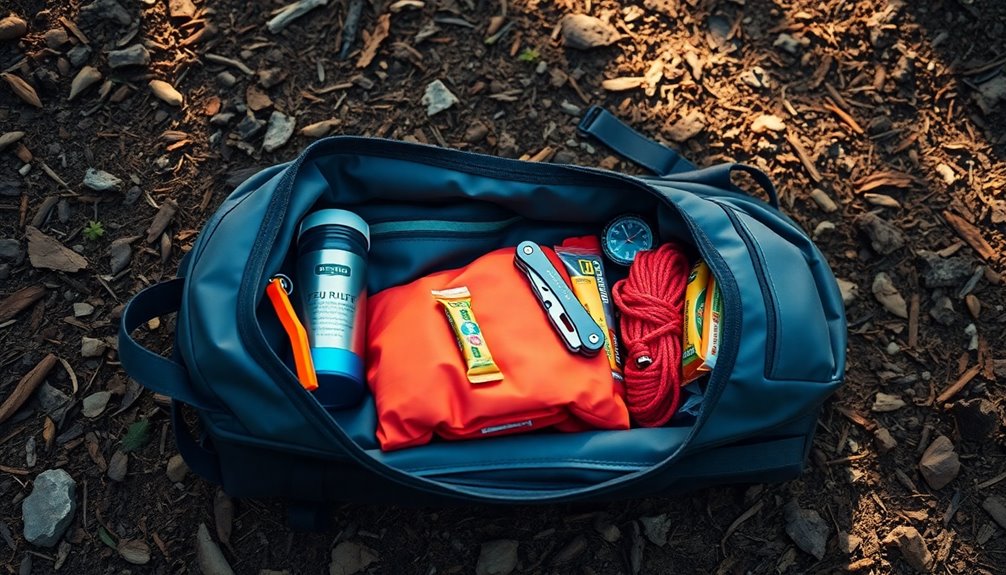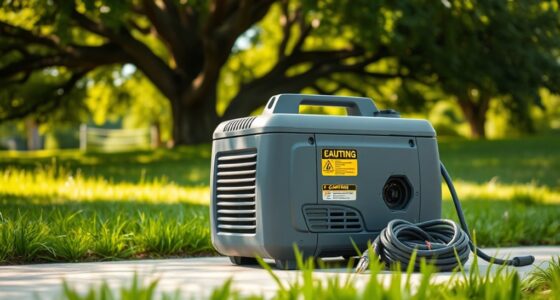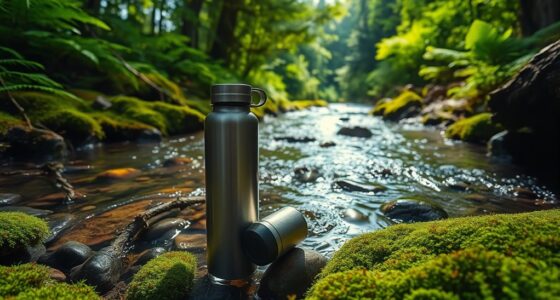To build your ultimate survival kit, start with essential supplies like non-perishable food and at least one gallon of water per person each day for three days. Don't forget a first aid kit with bandages and antiseptics, plus a reliable flashlight and multi-tool. Include communication tools like two-way radios and an emergency whistle. Tailor your kit to local threats, stocking seasonal items as needed. Regularly check your supplies for expiration and replace items accordingly. Mastering these basics ensures you're prepared for anything. Stick around; there's more valuable information waiting for you!
Key Takeaways
- Include non-perishable food and at least one gallon of water per person per day for a minimum of three days.
- Pack essential first aid supplies, including bandages, antiseptics, and pain relievers for injuries and medical needs.
- Equip your kit with a reliable flashlight, extra batteries, and multi-tools for various emergency tasks.
- Incorporate communication tools like two-way radios and emergency whistles to facilitate coordination during crises.
- Regularly maintain and update your kit every six months, replacing expired items and tailoring supplies to seasonal risks.
Introduction
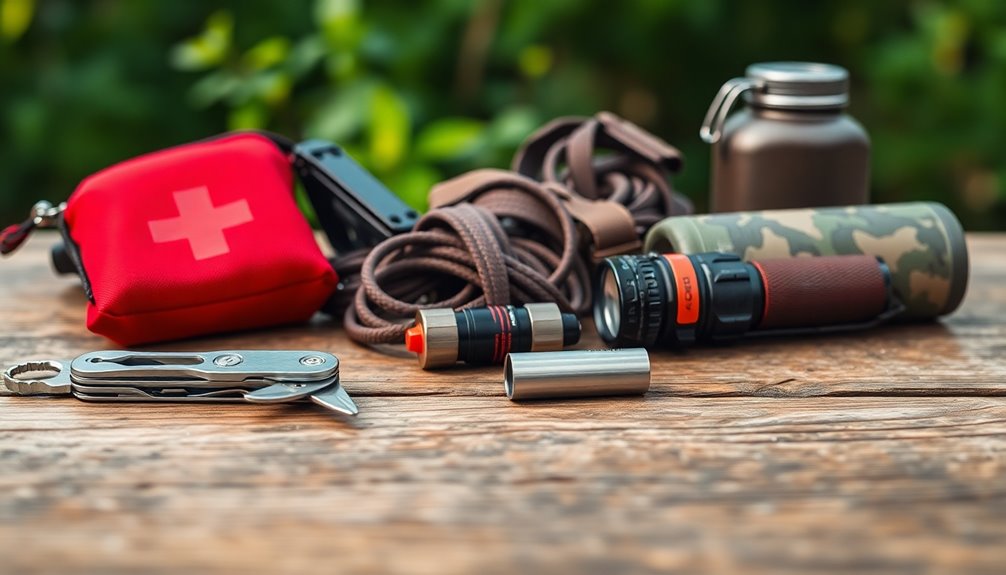
When emergencies strike, having essential supplies ready can make all the difference.
You need a survival kit that not only meets your basic needs but also prepares you for unexpected situations.
Understanding what to include in your kit is key to ensuring your family's safety and well-being.
Essential Supplies for Emergencies
Preparing for emergencies is crucial, as having the right supplies can make a significant difference in your safety and well-being.
Start by gathering essential items like non-perishable food items and at least one gallon of water per person per day for at least three days. Your survival kit should also include first aid supplies, such as adhesive bandages, antiseptic solutions, and pain relievers, to promptly address injuries.
Don't forget a reliable flashlight with extra batteries and multi-tools for various tasks.
Lastly, incorporate communication tools like two-way radios and emergency whistles to enhance safety and coordination.
Regularly check and update your emergency supplies to ensure everything remains effective and ready for use when you need it most.
Emergency Preparedness Objective
Emergency preparedness aims to equip individuals and families with the knowledge and resources needed to effectively respond to crises. By creating comprehensive survival kits, you establish essential lifelines that can significantly mitigate the impacts of disasters.
A well-rounded kit should include at least one gallon of water per person per day, non-perishable food supplies for a minimum of 72 hours, and first aid supplies that cover basic medical items. Regularly maintaining and updating your survival kits, including checking expiration dates, ensures your preparedness remains effective.
Engaging in educational quizzes about emergency supplies can highlight knowledge gaps and foster proactive learning in disaster readiness. By taking these steps, you're not just prepared; you're empowered to face any emergency situation.
Survival Kit Essentials Defined
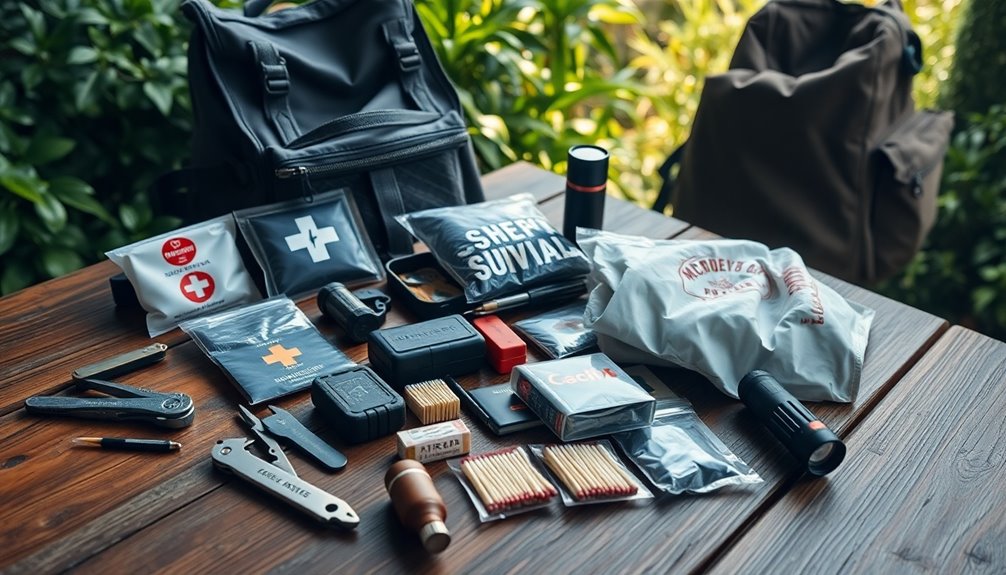
Building a well-rounded survival kit is essential for navigating unexpected crises safely and effectively.
Start with at least one gallon of water per person per day and ensure you have non-perishable food items to last at least 72 hours.
Don't forget essential first aid supplies like bandages, antiseptic wipes, and pain relievers to treat injuries and prevent infections during an emergency situation.
Compact tools such as multi-tools or knives, along with flashlights and extra batteries, are vital for various tasks and visibility.
Additionally, include communication devices like two-way radios and emergency whistles to enhance coordination and safety.
Regularly check your kit's contents, updating items as needed to ensure you're always prepared for any challenge that may arise.
Critical for Emergency Readiness
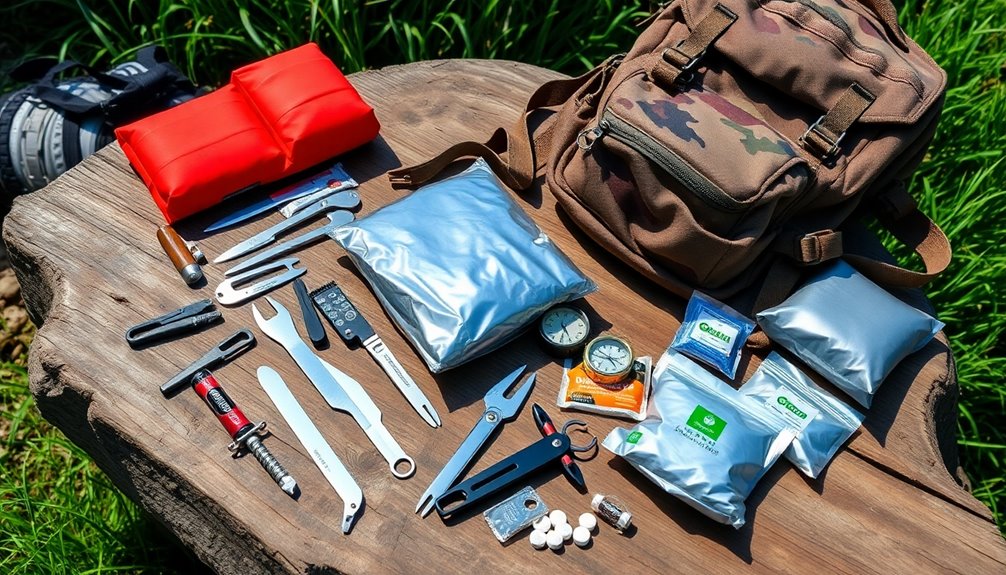
Emergency preparedness saves lives, and it starts with understanding your local climate and potential risks.
By knowing what emergencies to expect, you can tailor your survival kit to meet those specific challenges.
Let's explore how to ensure your readiness effectively.
Emergency Preparedness Saves Lives
A well-stocked survival kit can mean the difference between chaos and calm during a crisis. Effective emergency preparedness enables you to handle natural disasters with confidence.
Your survival kit should include essential medical supplies and a comprehensive first aid kit, featuring bandages, antiseptics, and pain relievers to treat injuries promptly. The Red Cross advises having at least one gallon of water per person per day and enough non-perishable food to last 72 hours. Additionally, consider including a portable camping toilet to maintain hygiene in emergency situations.
Regularly check and update your kit, ensuring accessibility and that nothing is expired. Educating your family about the kit's contents and usage boosts efficiency, allowing everyone to respond effectively in emergencies.
Being prepared not only saves lives but also enhances your peace of mind.
Local Climate Considerations
Understanding your local climate is key to preparing an effective survival kit tailored to your specific needs. Different regions face unique risks, like hurricanes, tornadoes, or extreme temperatures.
If you live in a colder climate, pack thermal blankets, extra layers, and hand warmers to combat hypothermia. In areas prone to wildfires, include N95 masks and fire-resistant blankets to protect against smoke inhalation.
For hot and humid climates, prioritize hydration solutions like electrolyte tablets and portable water purification methods to prevent heat-related illnesses.
It's essential to regularly review and update your emergency supplies based on seasonal weather patterns and historical climate data. This proactive approach ensures you're ready for whatever challenges may arise.
Emergency Communication Methods
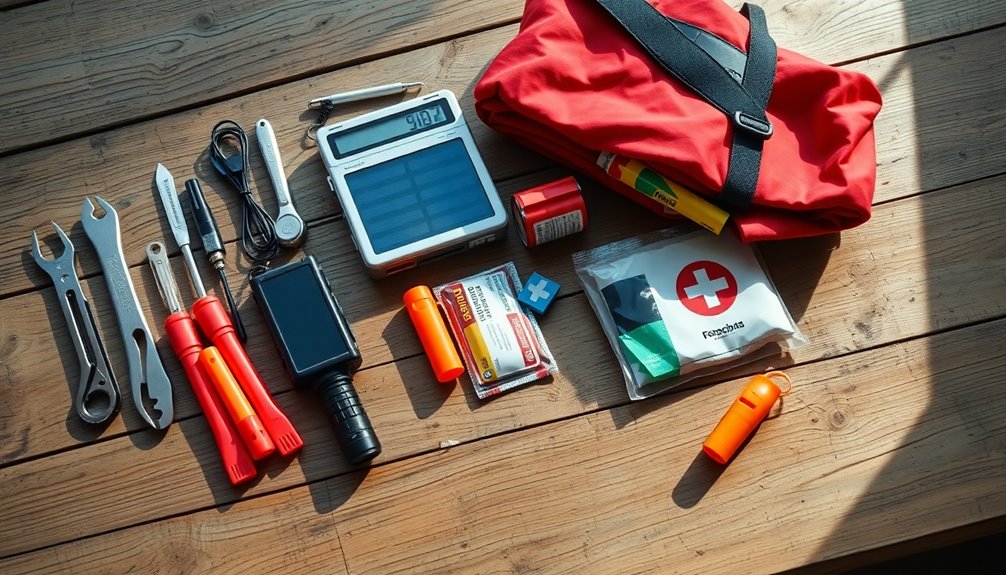
During emergencies, staying connected is crucial for your safety and well-being. Make sure your emergency kit includes reliable emergency communication methods.
Battery-powered or hand-crank multi-function emergency radios can receive AM/FM and NOAA weather alerts, ensuring you stay informed during power outages.
Consider using two-way radios or walkie-talkies for short-distance communication when mobile networks fail. A portable charger or power bank is essential for keeping your devices charged, especially in prolonged emergencies.
Don't forget to establish a list of emergency contacts and store copies in your kit, so you can easily access vital information.
Emergency Contact Information

In emergencies, having quick access to essential contact information can make all the difference. Start by keeping a written list of emergency contacts in your survival kit.
Include family members, close friends, and local emergency services, so you can reach out for help without delay. Don't forget to add medical professionals, veterinarians for pets, and your insurance companies to streamline communication during crises.
Make sure each entry has full names, phone numbers, and addresses to avoid confusion. Regularly update this list to reflect any changes in contact details, ensuring it's always current.
For added convenience, consider storing a digital copy on your mobile device or in cloud storage, so you can access it even if physical copies are lost.
Check Expiration Dates Regularly
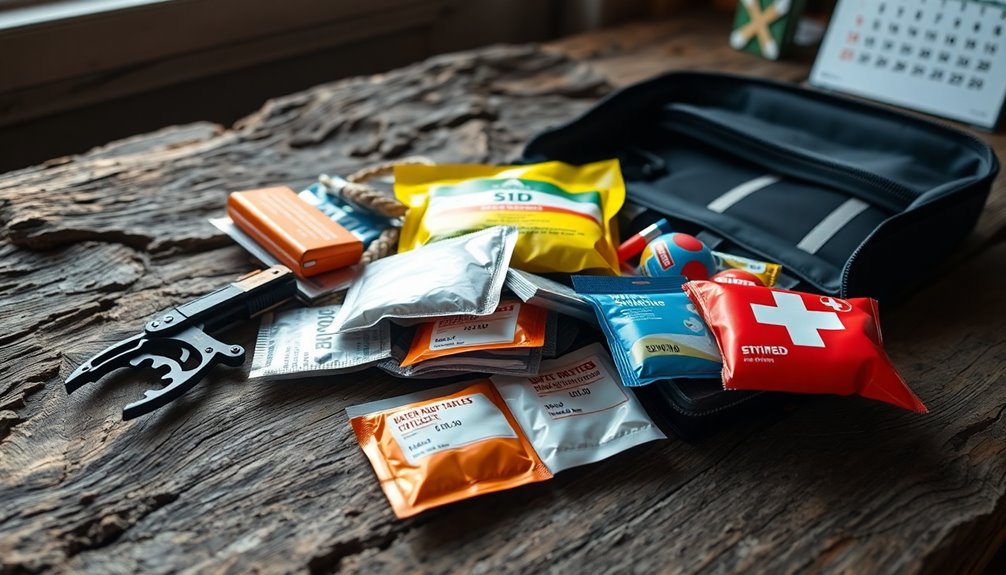
Expiration dates are a vital aspect of your survival kit's effectiveness. Regularly checking these dates ensures that your first aid supplies and emergency food remain safe and effective during a crisis.
Canned goods typically have a shelf life of 2-5 years, while emergency food bars can last up to 5 years. Don't forget about medications; they can lose potency after their expiration date, which can hinder treatment in critical situations.
Water purification tablets also need your attention, as they usually last 1-3 years from the date of manufacture. Establishing a biannual schedule to review your kit helps you replace expired items, enhancing your overall preparedness for any emergency that may arise.
Stay proactive to keep your kit reliable!
Limited Space for Storage
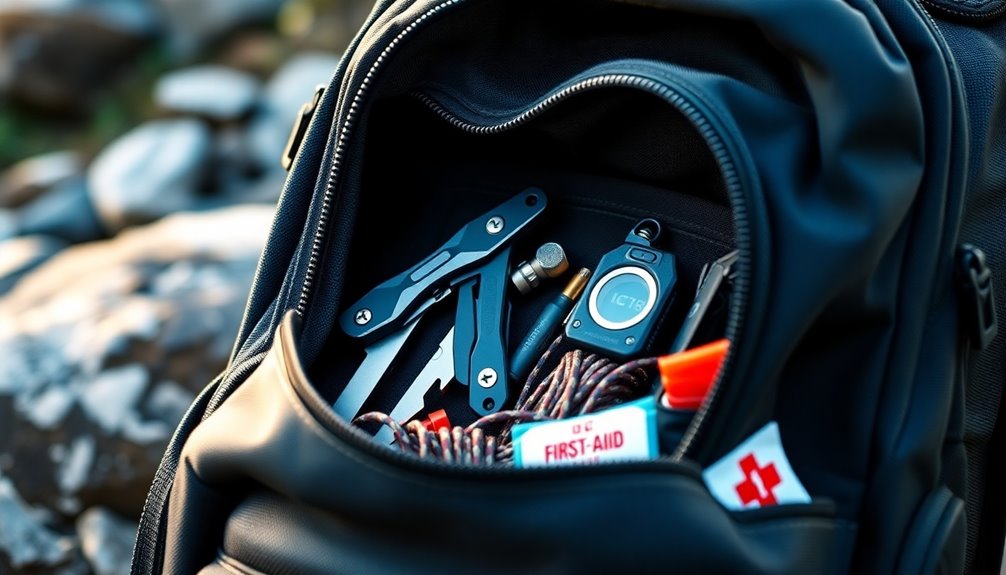
When space is tight, it's crucial to adjust your supplies seasonally and do regular inventory checks.
By swapping out items you won't need for the current weather, you can maximize your kit's effectiveness.
Keeping your kit lean and relevant ensures you have only what's essential when emergencies strike.
Seasonal Supply Adjustments
Seasonal changes can dramatically shift your survival needs, making it crucial to adjust your supplies accordingly, especially when storage space is limited.
In summer, prioritize water purification tablets and insect repellent to combat heat and pests. Rotate your non-perishable food to include seasonal fruits and vegetables that boost your nutrient intake.
As winter approaches, replace lighter supplies with thermal clothing and extra blankets for warmth. Consider vacuum-sealed bags to save space for these seasonal items.
Ensure your bottled water is fresh by rotating it every six months, particularly during warmer months when spoilage is a concern.
Regularly update your emergency supplies to reflect these seasonal adjustments, ensuring you're always prepared for any situation.
Regular Inventory Checks
Regularly checking your survival kit is essential to ensure you're prepared for any emergency. Conduct inventory checks every six months to confirm all items, including first aid supplies and emergency supplies, are in good condition and within their expiration dates.
Use a checklist to streamline this process, tracking essentials like water, non-perishable food, and batteries. Remember to store your survival kit in a cool, dry place for optimal shelf life.
Rotate your water supply regularly, ensuring you have at least one gallon per person per day. Prioritize compact items and multi-functional tools to optimize your limited storage space while ensuring you have everything necessary for unexpected situations.
Keeping your kit updated is key to your preparedness.
Hurricane Preparedness Success Stories
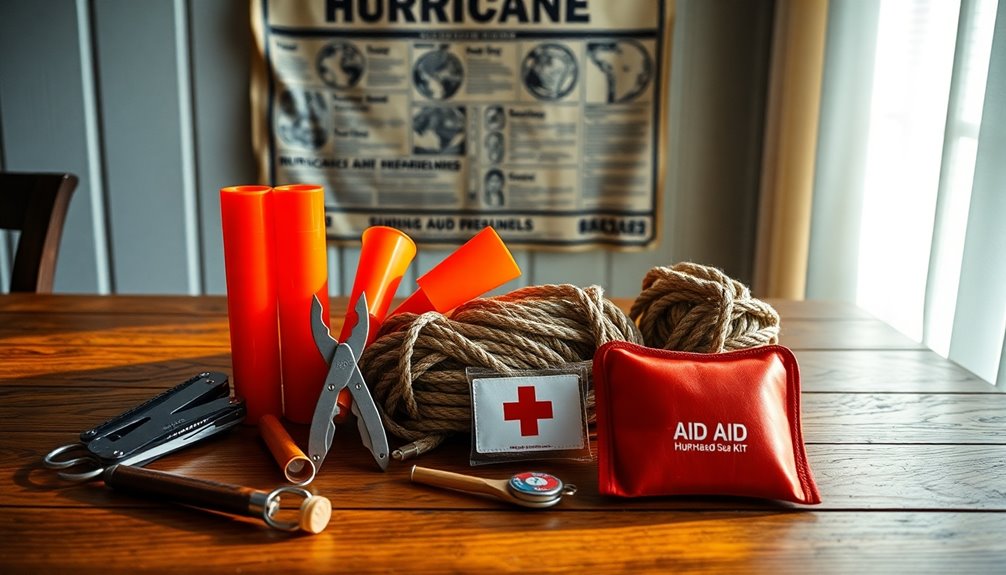
Hurricane preparedness can make a significant difference in the safety and well-being of families facing severe storms. Many success stories show how families in hurricane-prone areas relied on well-prepared survival kits filled with essential supplies like water, non-perishable food, and first aid supplies during events like Hurricane Harvey and Hurricane Katrina.
Communities that conducted regular emergency drills reported higher successful evacuations and fewer injuries. The Red Cross found that households with comprehensive emergency survival kits boosted their safety and communication by 60%.
Survivors of Hurricane Maria emphasized the importance of portable chargers in their kits for staying informed. Proactive hurricane preparedness initiatives, including distributing survival kits, led to a 40% reduction in property damage during major storms.
Conclusion
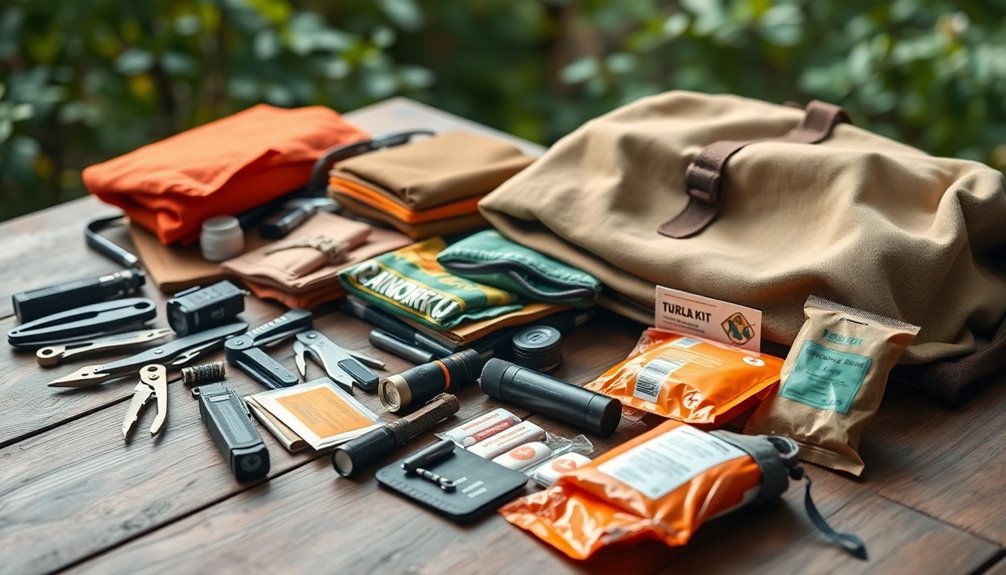
While disasters can strike at any time, being well-prepared with a comprehensive survival kit can significantly enhance your family's safety and resilience.
To build the ultimate survival kit, include essential components like first aid supplies, a flashlight with extra batteries, a multi-tool, and water purification methods.
Don't forget to stock at least one gallon of water per person per day and non-perishable food items for at least 72 hours.
Regularly maintain your kit by checking and updating supplies, replacing expired items, and ensuring accessibility.
Also, consider your family's specific needs, such as baby supplies, pet necessities, and personal medical items.
Educating all family members on the kit's contents will boost your emergency preparedness and confidence during crises.
Additional Resources
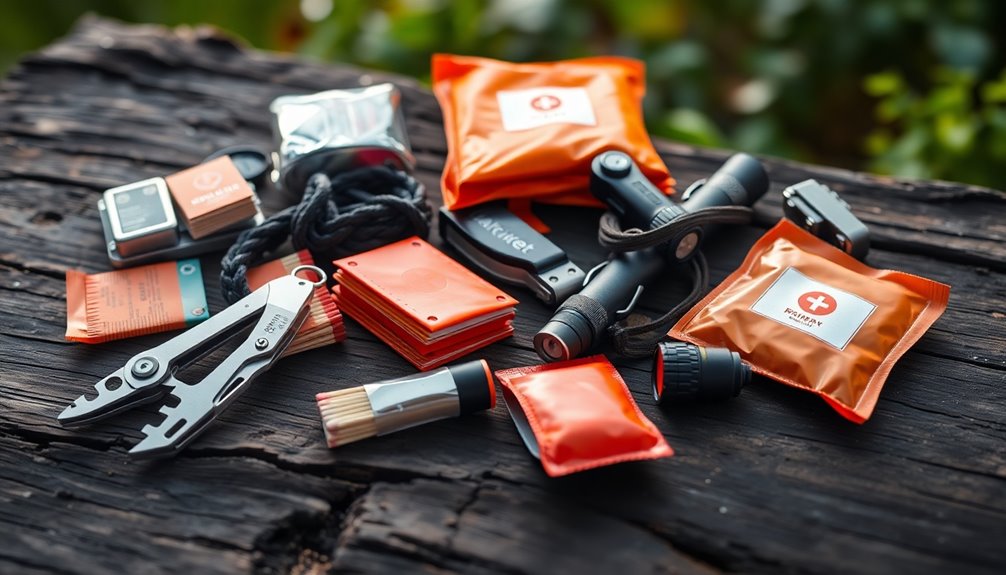
Once you've got your survival kit in order, it's important to explore additional resources that can enhance your preparedness.
The Red Cross Store offers a variety of survival kits and first aid supplies, helping you stay equipped for emergencies.
Make sure your emergency preparedness includes at least one gallon of water per person per day and non-perishable food for at least 72 hours.
Utilize educational resources like quizzes and guides to boost your knowledge on essential items and emergency procedures.
Regularly review your comprehensive kits to ensure all supplies are current and meet your family's needs.
Lastly, consider making donations to disaster relief efforts; even a small amount can provide vital supplies to those in need. Additionally, familiarize yourself with wood stove safety standards to ensure your heating system is safe during emergencies.
Frequently Asked Questions
What Are the 10 Essential Survival Kit Items?
When you're preparing a survival kit, focus on these ten essential items: one gallon of clean drinking water per person per day, non-perishable food, a first aid kit, a reliable flashlight with extra batteries, a multi-tool or knife, a whistle for signaling, a fire starter, emergency blankets, duct tape, and a map of the area.
Having these essentials ensures you're ready to handle emergencies effectively and stay safe during challenging situations.
What Are the 5 Most Important Survival Items?
When you think about the five most important survival items, consider water, non-perishable food, a first aid kit, a flashlight, and a multi-tool.
Water's essential for hydration, while non-perishable food keeps your energy up. A first aid kit helps you treat injuries, and a reliable flashlight ensures you can see in the dark.
Finally, a multi-tool or knife offers versatility for various tasks, making it indispensable in any emergency situation.
What Are the 7 Supplies That Are Needed for an Emergency Supply Kit?
When preparing for emergencies, you'll need seven essential supplies.
Start with at least one gallon of water per person per day for hydration.
Include non-perishable food items for at least 72 hours.
A comprehensive first aid kit is crucial for treating injuries.
Don't forget a reliable flashlight with extra batteries, a multi-tool or knife, a whistle for signaling help, and a blanket for warmth.
Lastly, a local map can help with navigation.
What Are 10 Items in an Emergency Kit for a Natural Disaster?
When preparing for a natural disaster, you'll want to include key items in your emergency kit.
Start with at least one gallon of water per person per day for three days. Pack non-perishable food, a first aid kit, and a reliable flashlight with extra batteries.
Don't forget a multi-tool or knife for various tasks, a whistle for signaling, blankets for warmth, hygiene products, important documents, and a portable phone charger.
Stay prepared!

